Best rear shocks for mountain bikes: from XC to DH and budget to bespoke
A rear shock plays a huge role in how a bike rides, however choosing the right one is a confusing endeavor, to help you decide here is our pick of the best rear shocks for mountain bikes
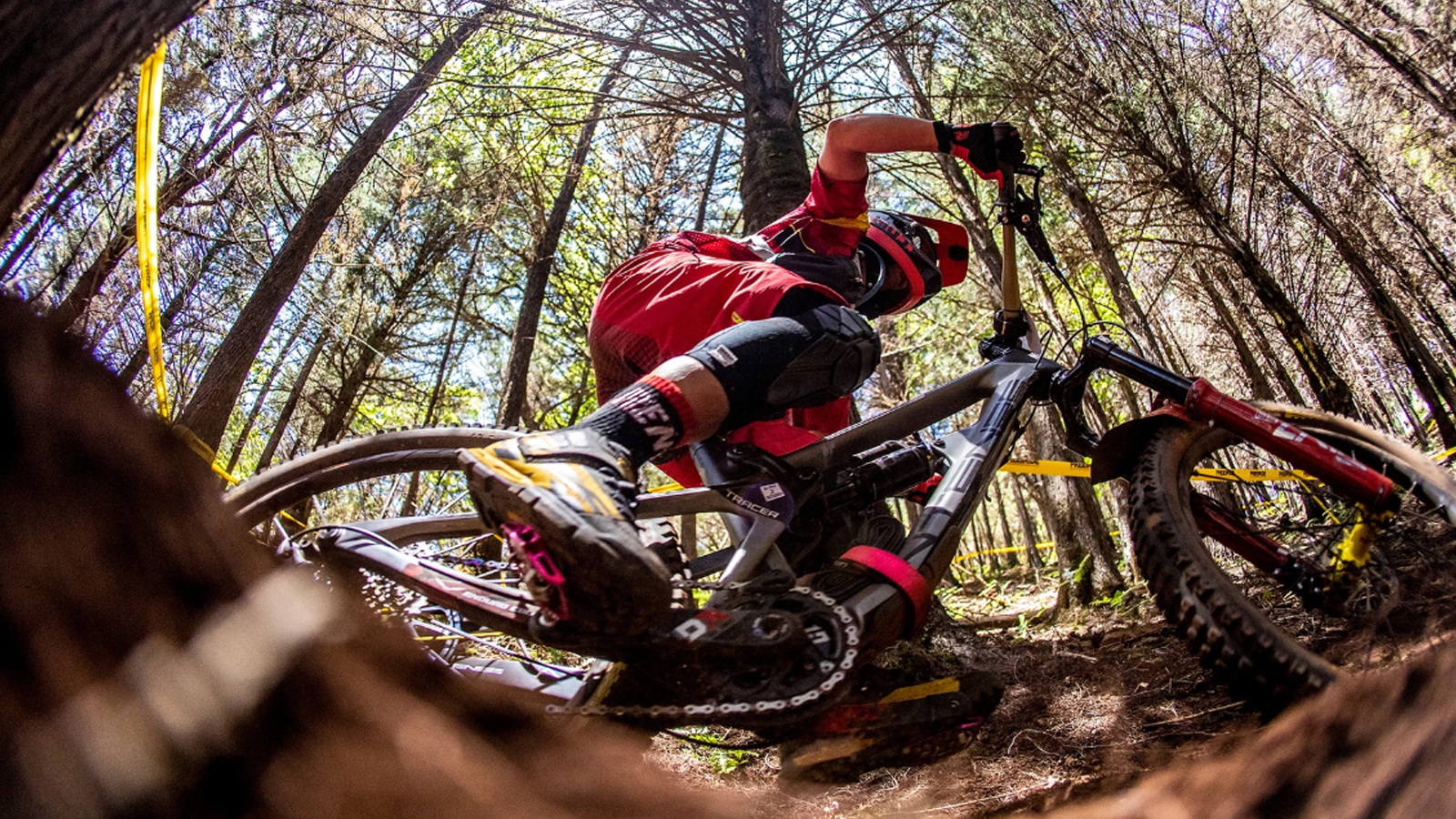
Choosing the best rear shock for your bike can be daunting. There are tons of different designs, and each company has unique technologies that they claim make their products better than all the rest.
But what are the best rear shocks for mountain bikes? There are a whole range of things to think about if you want to upgrade your rear damper or spec the right model of shock on a new bike build. Where do you start and what do you need to know?
This guide starts by listing the best rear shocks for mountain biking from companies like Fox, RockShox, Marzocchi and DVO. Choosing a shock is a bit more complex than other bike parts though. You'll have to choose between coil and air-sprung for starters. Plus, the most important factor is making sure you get a shock that's compatible with your frame. We have a rundown of all of this information at the bottom of the page.
If you're running air suspension, you'll also need one of the best shock pumps to maintain and set it up.
Best rear shocks for mountain bikes: air shocks
Why trust BikePerfect
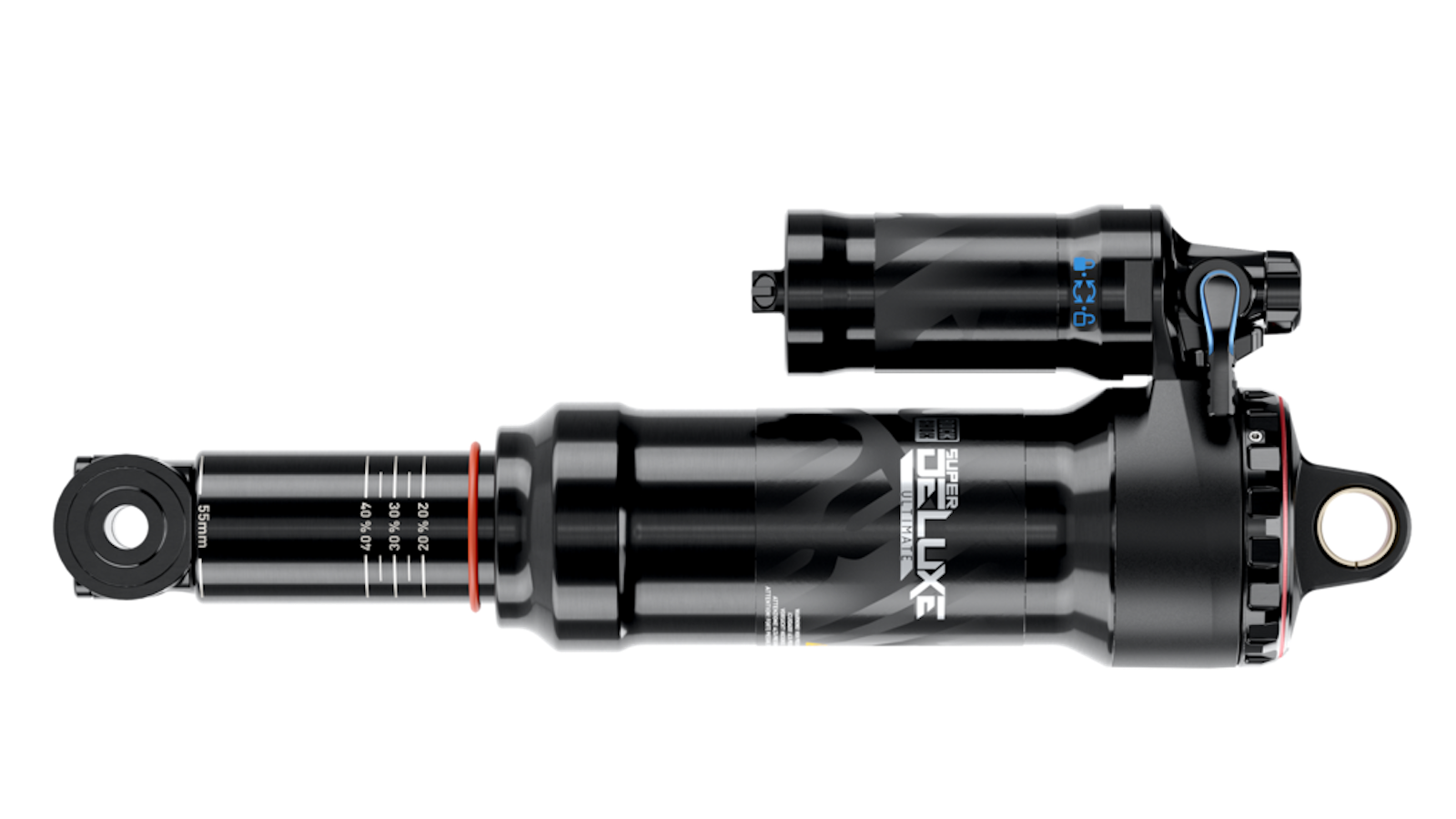
RockShox Super Deluxe Ultimate RCT
Our expert review:
Specifications
Reasons to buy
Reasons to avoid
If you want to know the geeky bits then one of the big-effect small-change details on the Super Deluxe Ultimate RCT are check valves on the rebound and compression circuits. These mean that oil can’t back-flow through valves and undermine the control from the valves it should be going through. Add seamless multi-point pressure leveling between positive and large-volume negative springs, plus top-quality Maxima suspension fluid as standard and you’ve got a super-sensitive, yet very accurately controlled, shock.
The ability of the shock to hold onto grip but suck up slaps rather than skipping and hanging up gets more obvious the faster you go through rougher terrain making it a fantastic choice for hard-charging bikes. Separate compression damping circuits for the open mode and the threshold settings for the side switch mean tuning pedaling character doesn’t affect cornering character either. The adjusters are all easy to get to and tool-free too, and the air can unscrew to add or remove volume-adjust spacers. You can even fit a massive MegNeg can upgrade for insane sensitivity and extra progression if you find your bike a bit numb or travel hungry.
The best thing about the Super Deluxe though is that even with a basic ballpark sag and rebound set-up it’s a remarkably controlled and predictable damper. Its performance bandwidth, range of adjustment, and an extensive list of sizes and mount standards also suit a very wide range of bikes and riders. The similarly impressive and user-friendly coil version is similarly priced.
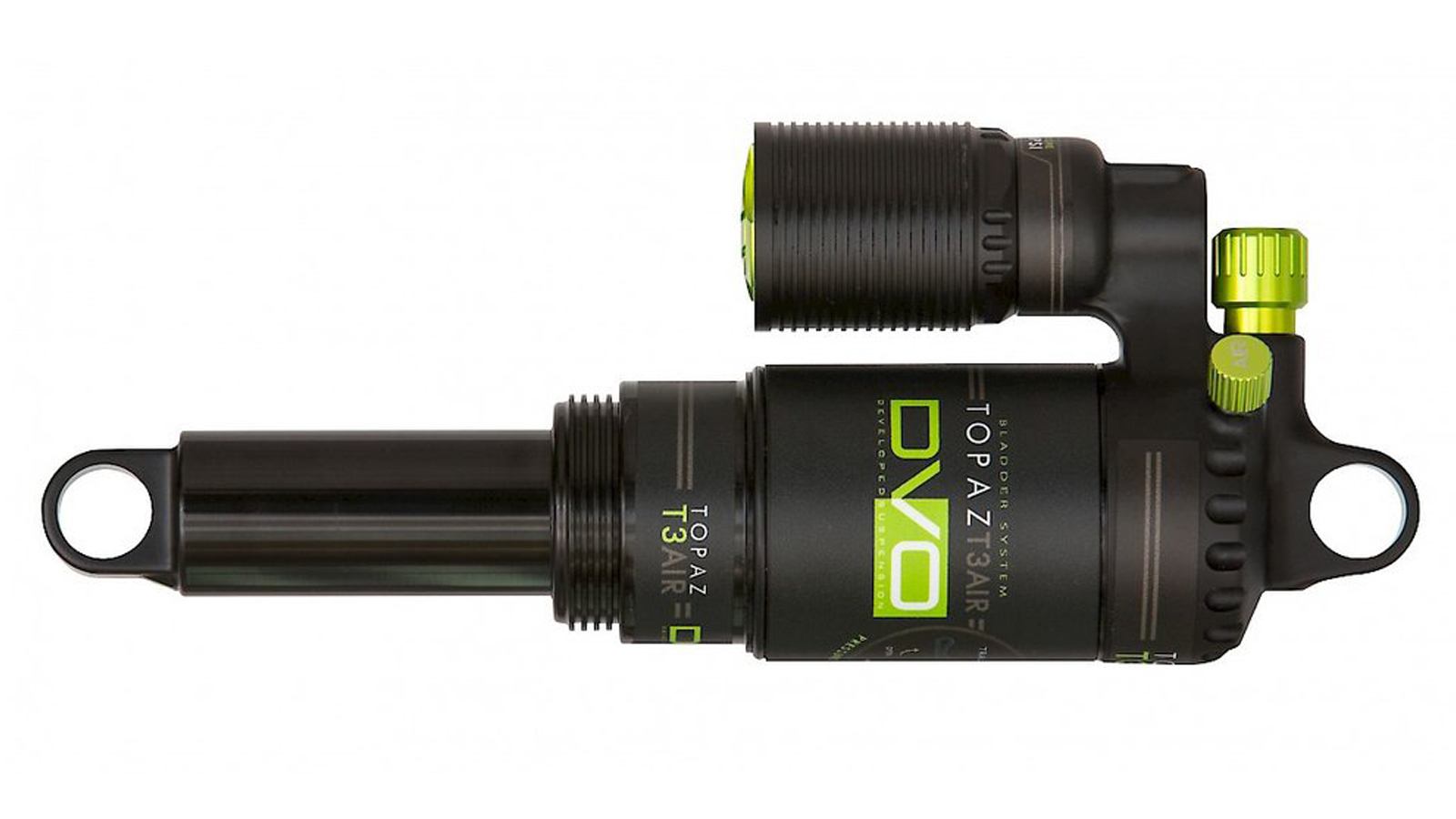
DVO Topaz T3 Air
Our expert review:
Specifications
Reasons to buy
Reasons to avoid
If we had to pick a shock that deserves more love and recognition than it gets, then it would have to be DVO’s hyper-adjustable but also user-friendly and impressively good value DVO Topaz Air.
Rather than a basic less tuneable version, DVO goes straight in with a full-feature shock that allows a ton of adjustment. Don’t worry if you’re not a fettler though as the same high flow-damping architecture as the Jade coil shock, plus a large air can and negative spring means it’s a naturally super-smooth unit. The low-speed compression lever on the side gives open, medium, and firm options that comfortably bracket the character of most bikes with just a flick of a switch, although the Firm option is less ‘locked’ than some if you’re a real pedal stomper.
While it’s one of the plushest shocks in its default set-up, preset high-speed compression and rebound, plus heat-dissipating fins on the piggyback give very good big-hit control too. If you’re a tweaker it’s also got a couple of tuning options unique to DVO. You can add volume spacers to both negative and positive air springs to adjust the spring rate either side of the sag point. The bladder pressure of the damper can also be adjusted to make the shock feel softer or firmer through its entire stroke, so you can create exactly the spring feel you want very quickly and easily.
Despite all this tweaking potential, it’s also pretty light for a piggyback at under 400g, so you’re not adding much mass if you swap it for an existing inline installation. While it’s a relatively rare sight on bikes, reliability has been great everywhere we’ve used it.
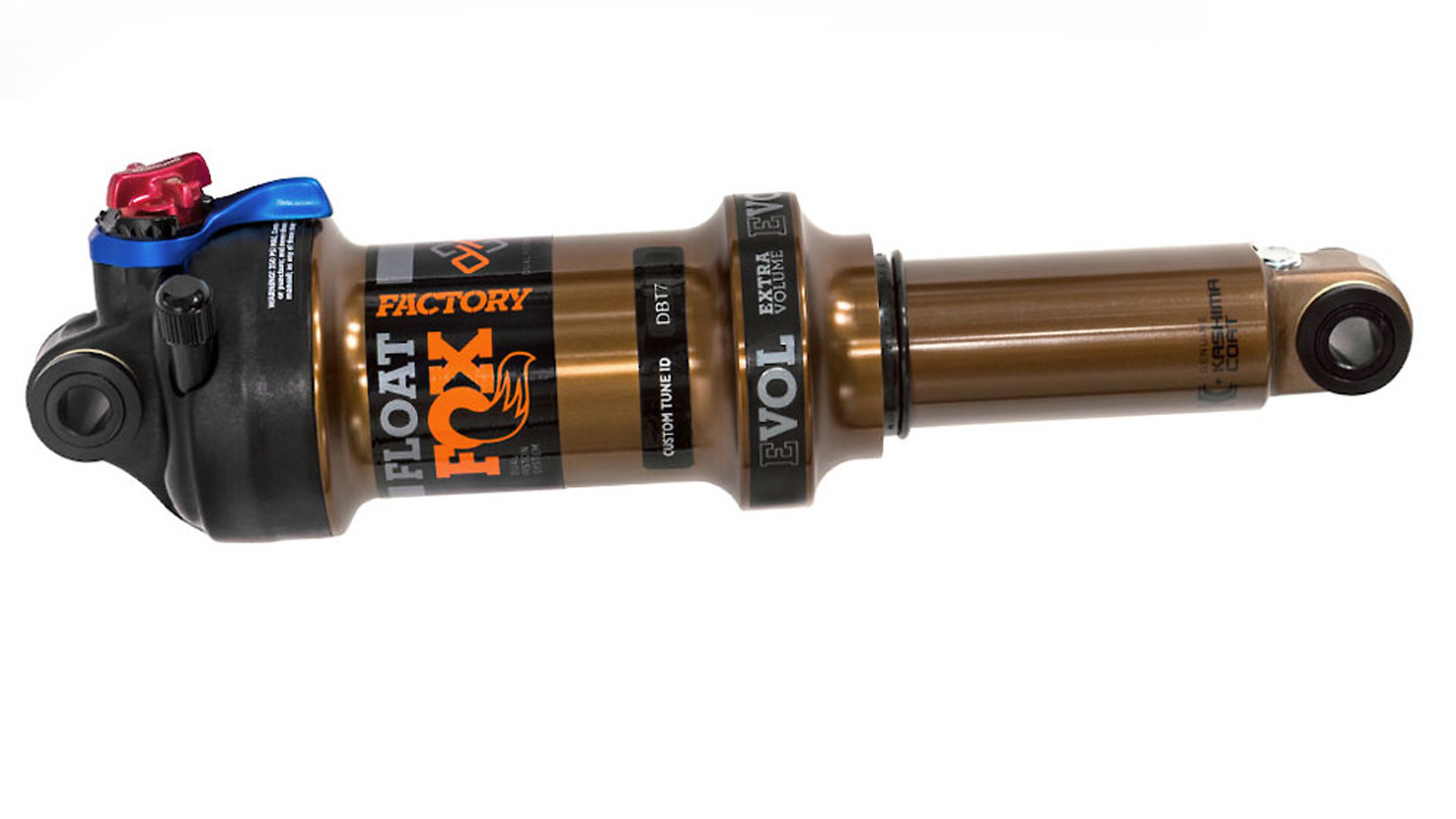
Fox Float DPS Factory
Our expert review:
Specifications
Reasons to buy
Reasons to avoid
Fox’s Float DPS Factory is literally the gold standard for XC shocks thanks to its distinctive Kashima low-friction air can and shaft coating. EVOL can options create a smoothly sensitive start stroke for sucking up patter bumps. The Open mode also gets separate low-speed compression damping adjustment above and beyond the three-position (Open, Medium, Firm) low-speed compression lever.
Separate compression and rebound pistons in the Dual Piston Base Valve mean you can make it feel efficient for pedaling while still getting great control when battering through seriously rocky, droppy sections. While you don’t get the additional Open adjust ‘gate’, the latest Performance grade shocks have significantly closed the previously very obvious smoothness/sensitivity gap over their golden siblings too.
Longevity and premium-ride feel mean Factory is still the way to go if you can afford it. Trunnion mount, remote control, small and large volume spring, imperial and metric sizing are all available, too.
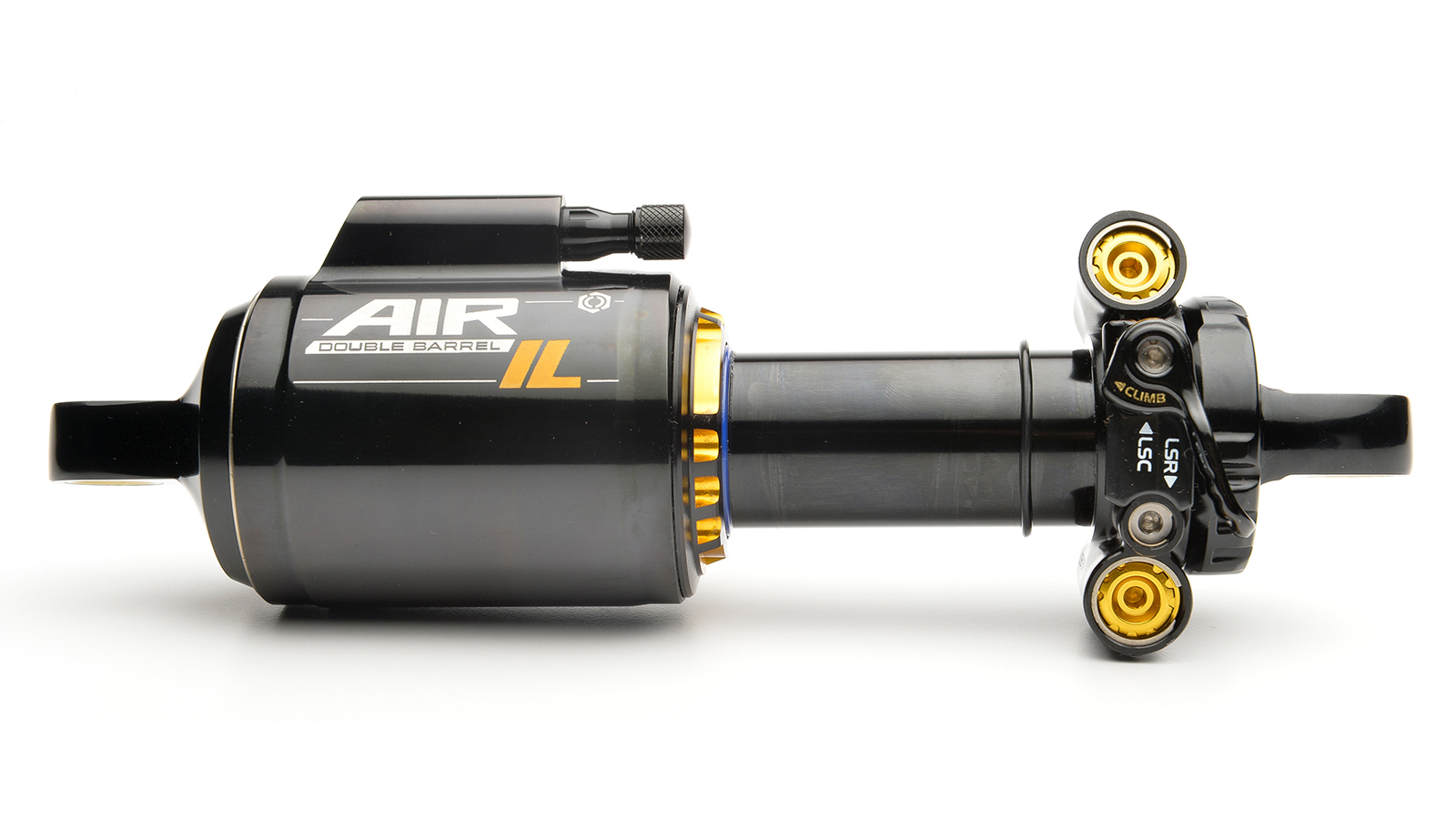
Cane Creek DBAir IL
Our expert review:
Specifications
Reasons to buy
Reasons to avoid
It might have had some hiccups early on but Cane Creek’s Double Barrel Air Inline (to expand the acronyms) has established itself as a very adjustable, well-controlled shock for riders after an efficient rather than plush feel. It’s a good price for the level of user tunability, too.
Cane Creek is another company using a twin-tube (or Double Barrel) design for continuous oil flow and tightly consistent control. High and low-speed rebound and compression are independently adjustable through a wide range to suit all riders, although you’ll have to use an Allen key, not just twist a dial, which is a pain when setting up. The ‘Climb switch’ adds low-speed rebound as well as low-speed compression, that mutes pedal bob really effectively while still letting the back end respond fast enough for impressive grip.
The “LinEair” spring name is slightly misleading as it’s still a reasonably progressive shock even before you add internal spacers. A small negative spring, by the latest standards, means it’s more stubborn to get moving off the top with a carefully metered rather than super supple feel through the opening phase. If you want a shock that feels very controlled and feedback-rich to add efficiency to a naturally fluid/neutral bike then the Cane Creek is awesome.
There’s also a plusher, bigger volume piggyback equipped DBAir CS and a coil version of the same shock which comes in an impressive range of sizes including trunnion mounts. There are no Trunnion mount options on the IL though.
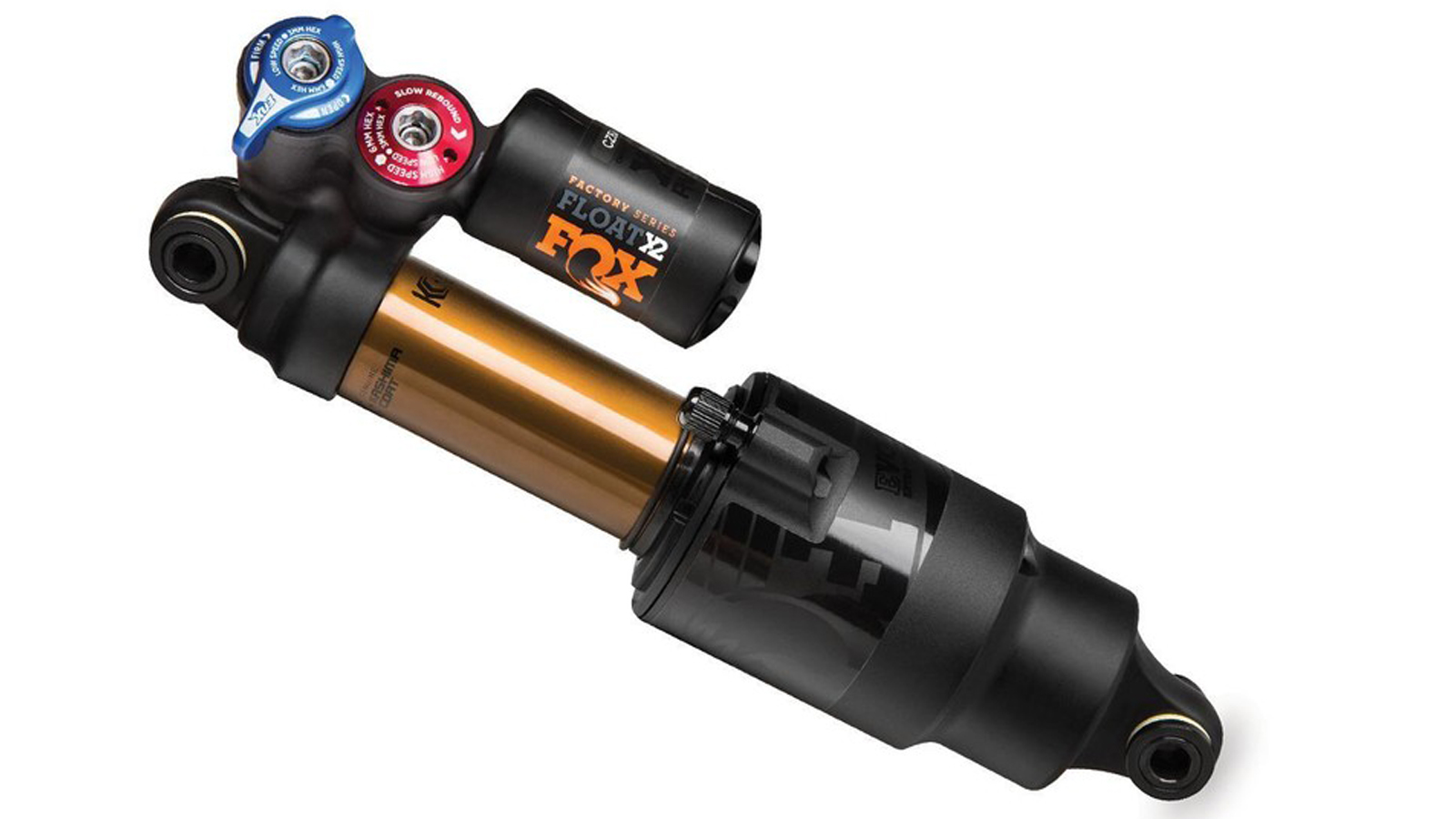
Fox Float X2 Factory
Our expert review:
Specifications
Reasons to buy
Reasons to avoid
The flagship Enduro shock in Fox’s lineup is potentially awesome as long as you’ve got the time to tune it. The Factory version gets Fox’s signature gold Kashima coating on shaft and air can to minimize friction and is impressively sensitive in terms of bump reaction anywhere in the stroke. The twin-tube damper constantly recirculates damping oil for a similarly fluid and consistent response however far and fast you descend.
Recent changes (snap-ring rather than grub-screw secured air can) have increased the maximum pressure rating for heavier riders. A tapered bottom-out bumper also gives a more progressive feel without relying on extra snap-in volume spacers. That means when you find the sweet spot of the high- and low-speed compression and rebound circuits, it’s a phenomenally composed and controlled shock when the trail is at its most challenging. For a little extra cash, the 2 POS version adds a low-speed compression lever for a firm climbing/sprinting mode and it also comes in a lot more sizes.
The bandwidth on what works and what doesn’t is pretty narrow though and while Fox’s double Allen key adjuster tool is super cute, the fact it exists at all is very telling in terms of time you’re likely to spend tuning. The fact you need two Allen key sizes rather than being able to just twist a dial is a pain too. While the generous negative spring potentially gives a really sensitive start, light riders on low leverage bikes might find the damping doesn’t open enough to get it. While mid-stroke support is excellent the increased progression can feel abrupt and excessive on bikes that already ramp up deeper in the travel. That means you’ll need to know how to tune your shock well and check that the shock suits your bike and your riding to guarantee you get the best from your X2. The DPX2 is generally even more of a faff to tune particularly in cheaper performance versions where a light rebound tune is vital to stop stroke choke. The price of either shock is high compared to the more forgiving and user-friendly RockShox Super Deluxe.
Best rear shocks for mountain bikes: coil shocks
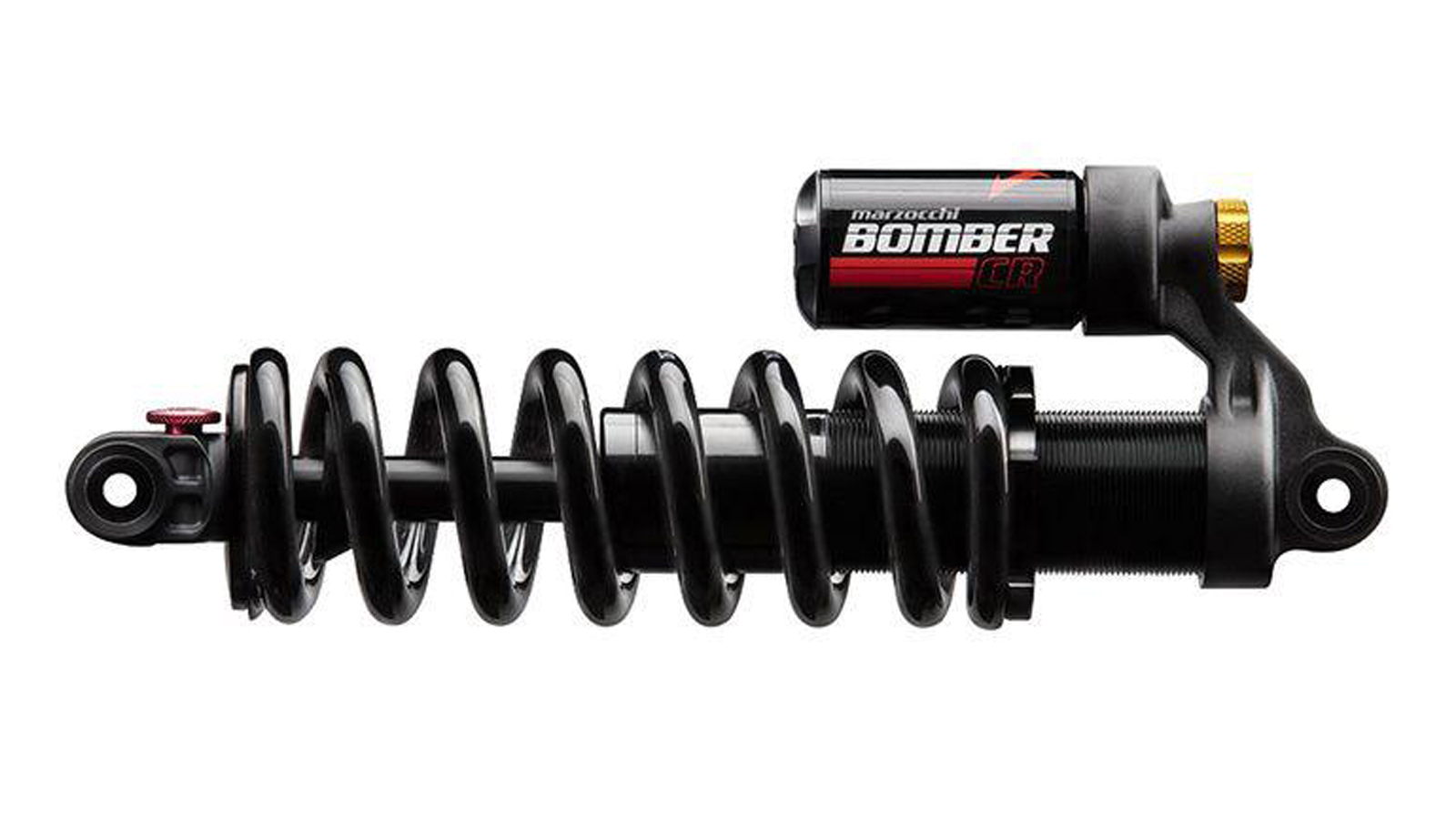
Specifications
Reasons to buy
Reasons to avoid
Fox’s VAN R coil shock has been the cost-effective, high-control, coil-sprung favourite of gravity riders for decades but it’s been discontinued. Don’t panic though as the new Marzocchi Bomber CR is basically exactly the same utterly proven shock with a different sticker on it.
As an added bonus you now get external low-speed compression damping adjustment via a dial on the back of the piggyback chamber. This lets you twist away pedalling bounce on particularly active bikes or stabilise cornering loads if you find the plush spring action too mobile. Wide-ranging rebound adjust means a controlled ride for a broad span of bikes and riders.
The preset damping has also been refined and dialled for over a decade to make this an impressively grippy and big-hit friendly unit at a bargain price. It’s also available in a trunnion-mount design as well as metric and imperial sizes. Don’t forget you’ll have to add the right weight of coil spring and fitting kit to the overall cost though.
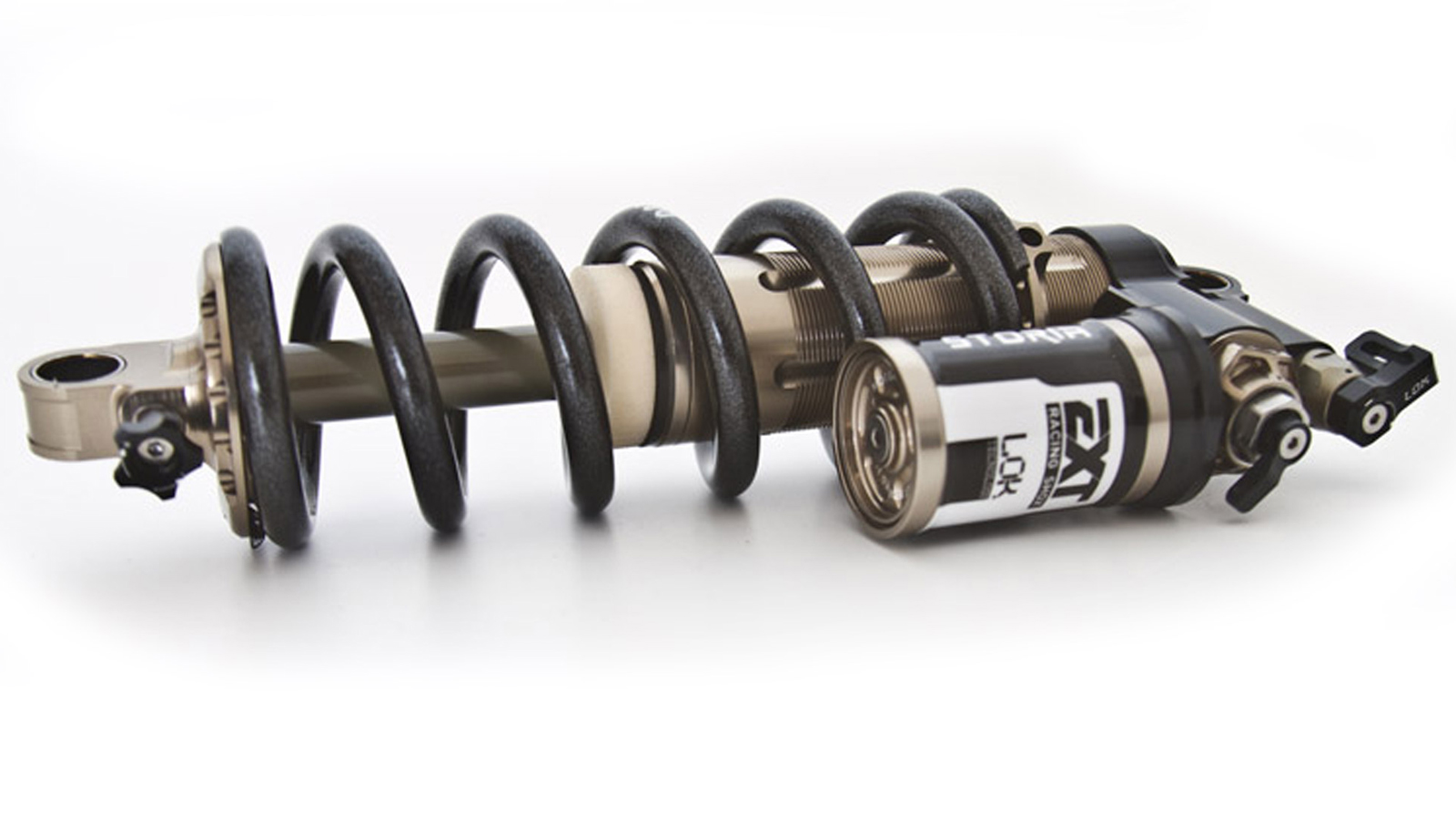
EXT V3 Storia Lok
Our expert review:
Specifications
Reasons to buy
Reasons to avoid
EXT’s Storia is a stand-out shock in price but also in how it’s delivered and how it performs. Rather than just buying off-the-shelf you need to fill in size, your weight, bike and riding info (style, pedal type, feel preferences etc.) and then wait for a specific custom tune. Some distributors (such as Mojo in the UK) would even prefer if you came in for a proper consultation and set-up session but, even by post, EXT has an awesome reputation for delivering an eerily accurate damping tune that generally sweet-spots personal preference and bike kinematics right in the middle of the range of the external dampers.
They also provide two lightweight coil springs (25lbs apart) with each shock for fine-tuning rides depending on conditions, kit or even your recent diet. The springs are also a lot lighter than normal as the Storia gets a cunningly simple, but very effective secondary piston and cup hydraulic bottom-out damper to add progression in the last 15 percent of the stroke. Combined with low piggyback reservoir pressure and high-volume valves that gives it a super sensitive performance through the start and mid-stroke. It also delivers enough ramp to make it suitable for more progression-dependent bikes than most coils are compatible with and you can even get custom shock and stroke lengths.
While all this helps justify the eye-watering price tag, it’s the brilliant ride quality of the Storia that makes it worth the money for proper limit-pushers and suspension-savants. As well as unholy levels of grip even in the most hellish conditions, it doesn’t over-damp feedback so you’re left with a lively, agile and responsive feel that coil shocks often lack. It’s also lighter than most coil shocks with a totally independent, side-lever actuated ‘LOK’ compression circuit for stiffening-up climbing performance.
That makes it a superb performance upgrade for all-day/enduro bikes, not just a ground-hugging gravity-specific shock that’ll kill the climb and contour parts of your ride. The 12mm wrench/socket needed to adjust the high-speed compression is a pain in the neck though.
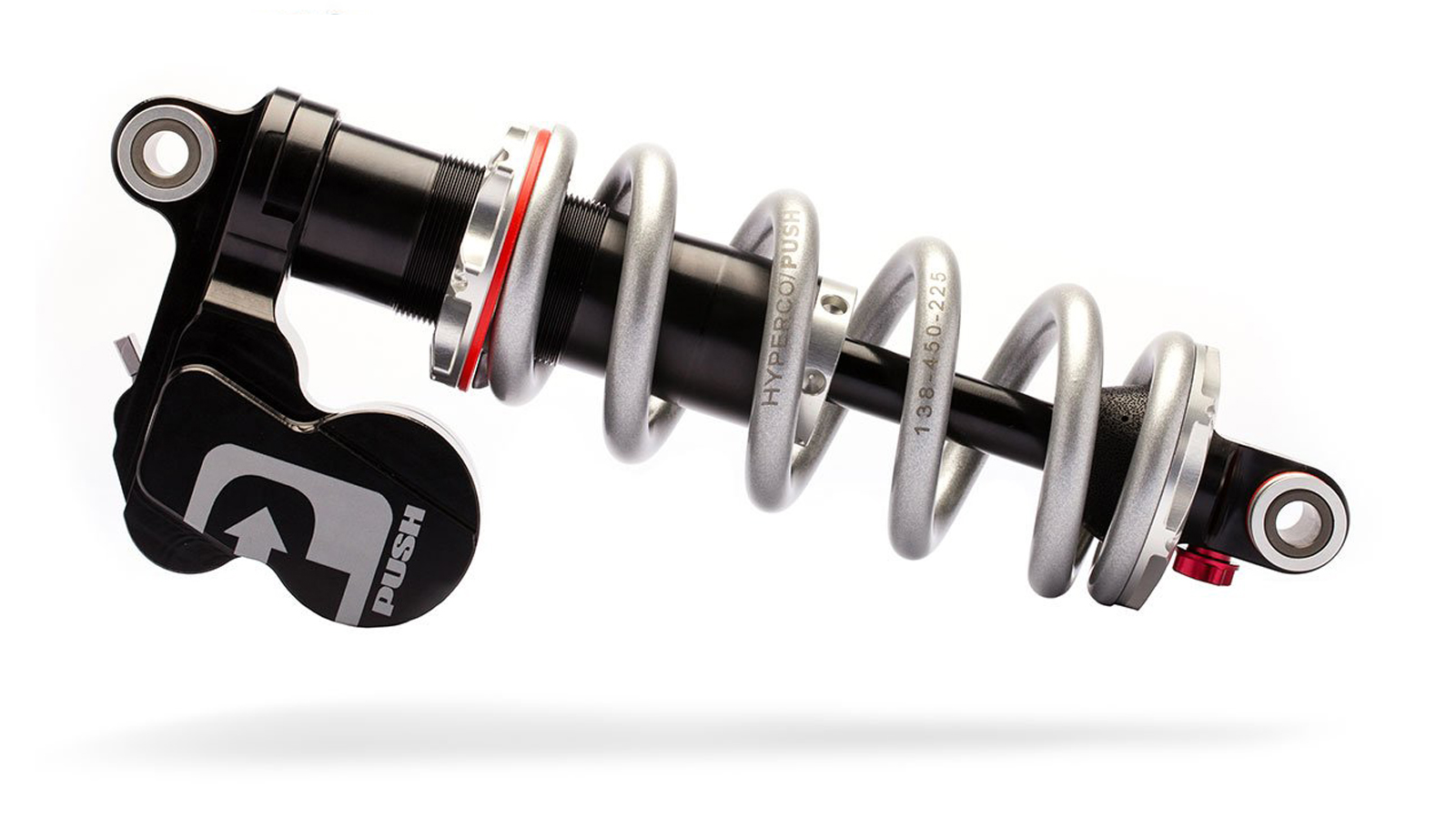
PUSH ELEVENSIX
Our expert review:
Specifications
Reasons to buy
Reasons to avoid
You can buy a complete and impressively competent full-suspension bike for the cost of PUSH’s ELEVENSIX shock, and the bulky valving set-up on the piggyback neck means it fits fewer bikes than most. If you’re after superlative shock performance with a unique dual personality switch function and multi-bike adaptability it might be worth the money though.
Like EXT all PUSH shocks are custom built depending on your weight, riding style, bike and other preferences. Unlike other shocks where the toggle lever on the side just operates a low-speed compression valve for climbing, the ‘Dual Overhead Valve’ switches between two totally independent but identical compression circuits. Both of them have external low- and high-speed adjusters so you can set them up to totally different full spectrum damping. Whether that’s very different open and firm feels for descending and climbing or subtly different gravity tunes for different runs during an enduro (or different sections of the same long course) is entirely up to you and unique to the ELEVENSIX. It’s worth noting that the rebound will be the same for each setting though and obviously it doesn’t take long to change settings on a conventional shock between runs if you’ve noted down the right ones previously.
The ultra-high cost does get you a load of extra detailing such as a Hyperco spring that’s thicker gauge in the center (apparently for a more linear feel) and even a parabolic-shaped rebound valve needle. The Colorado-built shock is also supplied with notes detailing who built the shock, who did the final check and a printout of the pre-shipment Dyno check. What really matters though is that the shock feels super-composed and ultra-grippy on the trail, with outstanding tracking and the ability to catch serious landings to flat without flinching.
It’s definitely a damped rather than agile-feeling shock by default though, and the very linear feel means it will only suit coil-optimized bikes. The bulky DOV assembly and transverse-rather-than-inline piggyback mean the physical fit can be an issue too. There are specific builds for lightweight riders and the modular design can be rebuilt to fit different mounting standards, travel and lengths at a third of the price of a new PUSH shock.
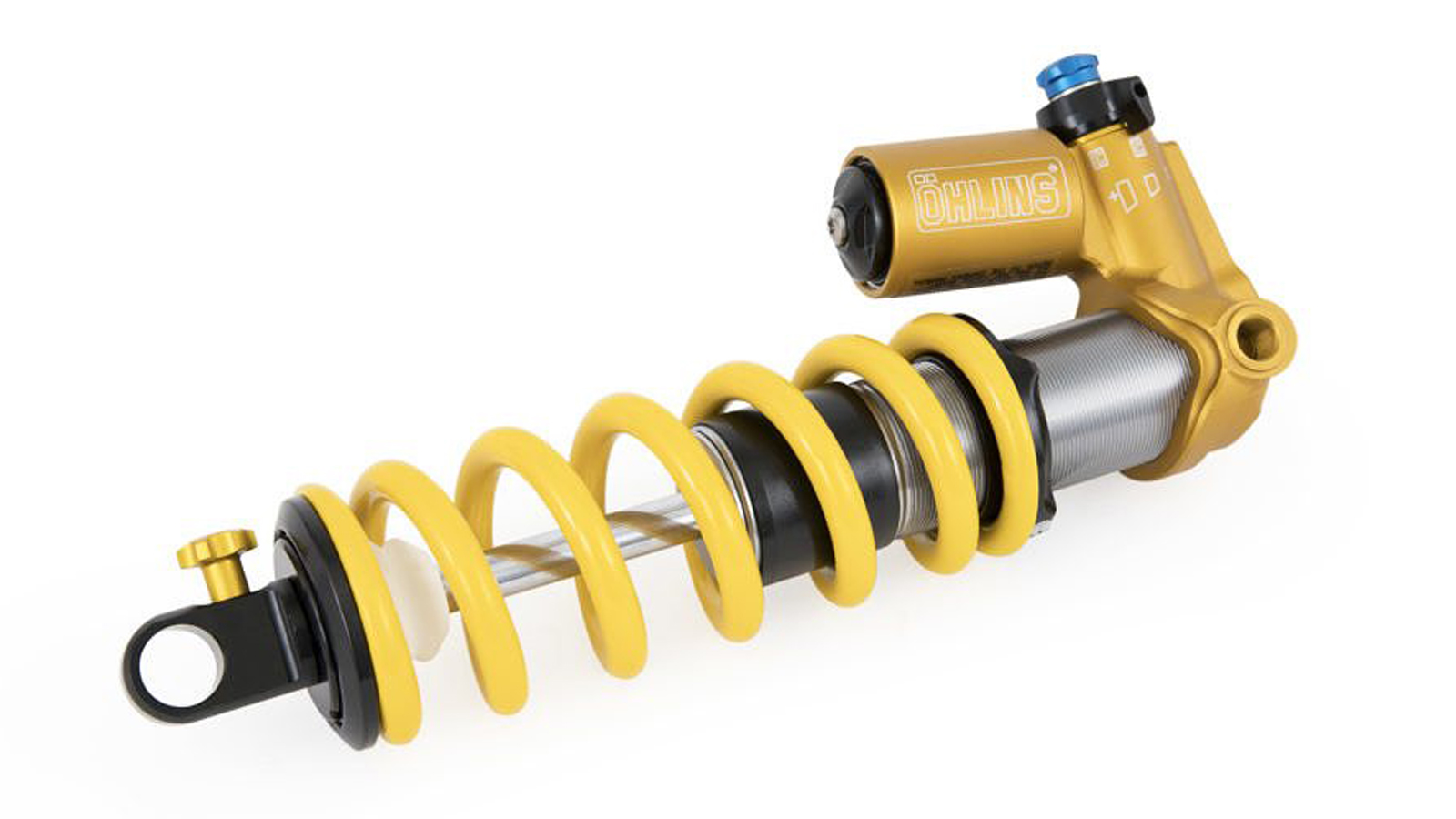
Ohlins TTX22
Our expert review:
Specifications
Reasons to buy
Reasons to avoid
Ohlins are a benchmark brand in performance motorsport suspension and they’ve had some great World Cup success under Loic Bruni, but it’s fair to say their first steps into mass-market MTB solutions - particularly air-sprung ones - haven’t been that smooth.
The good news is that they’ve binned off the original STX22 air shock and replaced it with the TTX Air. As you might guess it’s based around the twin-tube damper set-up from the excellent TTX coil shock and even gets the same Allen key to adjust low and high-speed compression adjusters. In a break from the ‘lockout lever’ norm, Ohlins have moved the high-speed compression adjustment onto a three-position side-lever though. That means the first two positions adjust how fast the shock can compress through its stroke in big-impact situations - similar to the two-way adjust on the PUSH. However, the third position adds both low- and high-speed compression damping so it is effectively a pedal-firming climb switch, although still a fair way short of a fully rigid lockout.
Rather than going the ‘bigger negative spring’ route, Ohlins has just reduced friction wherever possible in seals, lubes and longer bushings to create a structurally stiffer but more sensitive, 'eager-to-move' shock that’s right up there with the most responsive competition. Volume spacers are included to increase progression, too. The shock also comes in ten different sizes for different bike kinematics and there’s an extensive online tuning guide.
Best rear shocks: what you need to know
1. Do you need a new rear shock?
The first thing we always ask with suspension is do you really need to change it? Apart from proper budget bikes where cost means compromise, most machines come with a damper that’s been picked for a reason and tuned to suit too. That means your shock might feel rubbish just because it needs servicing which is a much cheaper option over a new shock. If you want it to ride differently then you can probably get it tuned to your tastes at the same time and some basic shocks can be upgraded with more sophisticated adjusters or even fancier shafts and cans too. Don’t be too hasty in throwing away a shock that can be fixed for a fraction of the price of a new one.
2. Cost
Shocks aren’t cheap either. They’re not as expensive as forks but there’s still a lot of complex engineering in there to pay for. That makes choosing an older ‘known brand' shock on special offer tempting, but if your bike is relatively recent it’s likely to need a metric rather than imperial-sized shock which rules out a lot of dated dampers.
What you generally get if you pay more is more control. Whether that’s with more external damping adjustment or the addition of a separate piggyback chamber. As always don’t pay extra for something you don’t need or understand though, make sure you’re honest about the riding you do as that’s the only information the builders/tuners have to work with.
3. Fit
Most modern bikes now use metric rather than imperial sizing, but you should be able to find a close fit in either format. The dimensions you need are the eye-to-eye length (horizontal distance between the center of each mounting hole) and the shaft stroke. Read the decal on stroke though as some shocks don’t compress all the way. Never add more stroke or length without checking with the bike manufacturer as you risk tires or linkages smacking into your frame and voiding your warranty.
Different shocks use different designs and bushing widths and bolt sizes aren’t standard either. Be sure to get the right type as while end-eyelet mounting is still the norm, trunnion shocks (where the mounts are on the side, not the top) are becoming more popular. If in doubt get it sorted through a shop you trust so they can double-check details and work out any issues for you.
4. Coil or air?
We’ve listed air and coil shocks here but air shocks are what most bikes are designed around and the best choice for most riders too. They’re lighter (by 200-400g) and easy to adjust for different rider weights and spring rates just by changing air pressure and volume. How much they sag and compress is a lot easier to check too, so that makes set-up and tuning easier. They generally work really well even in high load enduro and downhill environments, too.
Coil shocks need the right spring for your weight, bike and riding style and they need a bike that’s designed to work well with them. If you get them set-up right fewer seals mean they are more sensitive. A metal coil is a more stable spring medium than compressed air so control can be more accurate. They make you look like a gravity badass too, which is why most people get them.
5. Inline or piggy?
Standard all-in-one tube ‘Inline’ shocks are fine for most riders too. However, if you’re regularly descending really long, rough trails you’ll notice how hot your shock gets as the oil flows back and forwards through the valves, turning the impact energy into heat. At this point having a piggy-back chamber to add more oil volume reduces the effect of that heat build-up. Because they’re designed for more demanding users, piggy-back shocks generally have more advanced damping adjustment and better control overall too.
6. Adjustments
All decent shocks come with adjustable rebound damping (generally a red knob) which you can use to balance the return rate against the air pressure/spring weight you run to stop you bouncing or getting bogged down. The next addition is generally low-speed compression adjustment. This increases the force needed to get the shock moving which can stabilize pedaling, cornering and body movement loads. That’s why it often comes in the shape of a (blue) climb/pedal lever and if there’s a remote control attached, this is what it’ll be working. Next comes high-speed compression which stops the shock pushing through its travel too quickly and then you can get high-speed rebound adjustment. Don’t bother spending money on adjustments you don’t need/understand though and also realize that some simpler shocks actually work better in some situations (RockShox Monarch R were great over big hits in the right bike) as they have less valving and better oil flow than complex designs.
Some designs also have external bottom-out control for really big hits, but most air shocks can be made more or less progressive by adding volume spacers into the air can, which is way simpler than it sounds.
You can also change the can size on some air shocks to increase spring volume for a more linear and often more sensitive feel, but most bikes come with a large-volume (Debonair or EVOL) shock as standard now anyway.
7. Tunes
One aspect that’s very rarely talked about when buying shocks is the preset tune, which is stupid as it’s massively important. A proper suspension tuner or shock specialist will choose - or adjust - a shock to suit your bike and riding style which is money very well spent. Most off-the-shelf shocks just come with a medium rebound/medium compression tune (marked with two letters on red/blue background on the seal collar of RockShox or as a four-digit product ID code on Fox) which can be entered onto the help page on their website. Obviously, if you want the same basic damping range as previously then make sure these match up. If you want to change the background range then pick your tune accordingly. It’s worth noting that different shocks have different damping ranges and some - such as Fox DPX2 - work far better with one tune (light rebound) than others.

Guy Kesteven has been working on Bike Perfect since its launch in 2019. He started writing and testing for bike mags in 1996. Since then he’s written several million words about several thousand test bikes and a ridiculous amount of riding gear. He’s also penned a handful of bike-related books and he reviews MTBs over on YouTube.
Current rides: Cervelo ZFS-5, Specialized Chisel, custom Nicolai enduro tandem, Landescape/Swallow custom gravel tandem
Height: 180cm
Weight: 69kg
